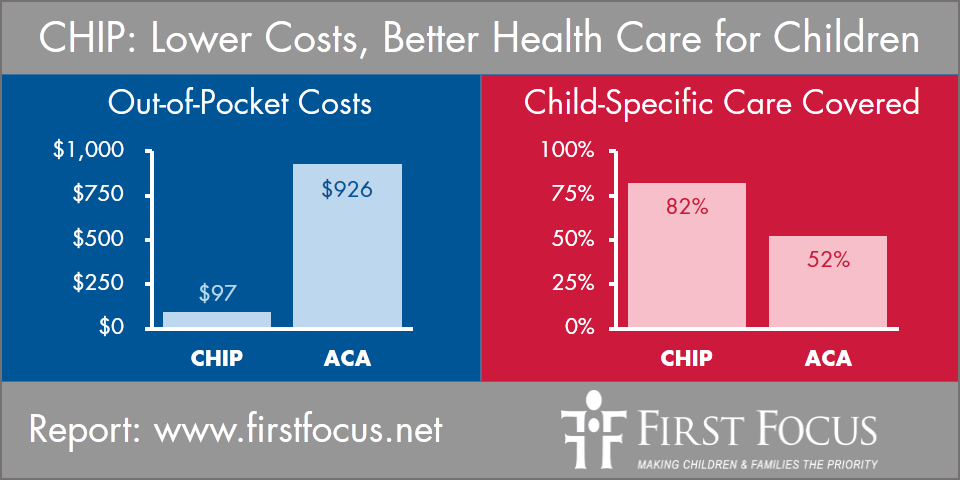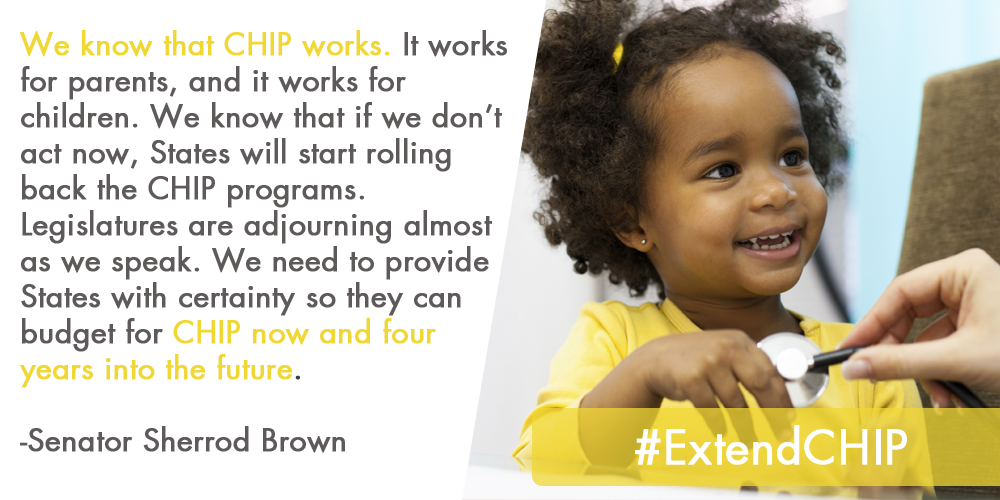 The Children’s Health Insurance Program (CHIP) turns 18 this year and has been an unqualified success story. Over 8 million children in working families with income too high to qualify for Medicaid but too low to buy affordable health coverage receive health care through it. In tandem with Medicaid, CHIP has cut the nation’s uninsured rate for children in half since its creation.
The Children’s Health Insurance Program (CHIP) turns 18 this year and has been an unqualified success story. Over 8 million children in working families with income too high to qualify for Medicaid but too low to buy affordable health coverage receive health care through it. In tandem with Medicaid, CHIP has cut the nation’s uninsured rate for children in half since its creation.
Reflecting that success, CHIP has strong bipartisan support from our nation’s governors, over 1,500 organizations from across the country, and an array of dental organizations. In an American Viewpoint poll, voters expressed overwhelming support (74-14 percent) for extending the program.
Simply put: CHIP works.
And yet, CHIP has witnessed a few near death experiences over the years and its future is at risk, once again, due to the fact that funding for the program expires this September. Although both Democrats and Republicans in Congress have introduced bills and proposals about how best to proceed, we live in an era where money and politics take precedence and the question of doing what is “in the best interest of children” is far too often forgotten or ignored. That must end.
CHIP’s Development and Improvement
CHIP was established in 1997 during a different era in which Democrats and Republicans often worked together to find common ground. The final compromise was forged by a bipartisan group in the Senate Finance Committee and based on legislation by Senators Orrin Hatch (R-UT), Edward Kennedy (D-MA), John Chafee (R-RI), and Jay Rockefeller (D-WV). The legislation, signed into law by President Bill Clinton, provided states with a great deal of flexibility to choose to use their CHIP dollars to form a separate state program or to use Medicaid to expand coverage to children.
Although both parties had to compromise over the structure, CHIP highlights how, when policymakers actually think about and act upon what is in the best interest of children, good things can happen.
For example, in partnership with advocates, families, and providers, states established unique CHIP plans that are child-focused and address the special health and development needs of children. And over time, CHIP has been improved as states chose to reduce out-of-pocket costs, improve benefits, and strengthen pediatric provider networks for children.
In addition, at the federal level, improvements have been made to CHIP on a bipartisan basis. For example, in 2004, President George W. Bush, recognizing the popularity of CHIP across the nation, spoke at the Republican National Convention and said he would initiate a major effort to expand outreach and enrollment to children. As he said:
“America’s children must also have a healthy start in life. In a new term, we will lead an aggressive effort to enroll millions of poor children who are eligible but not signed up for the government’s health insurance programs. We will not allow a lack of attention or information to stand between these children or the health care they need.”
After Bush’s reelection, Majority Leader Bill Frist (R-TN) and Senator Jeff Bingaman (D-NM) introduced bipartisan legislation based on the President’s initiative. This provision, which provides funding to expand outreach and enrollment efforts to children, was included in CHIP when Congress passed and President Obama signed into law the Children’s Health Insurance Program Reauthorization Act of 2009 (CHIRPA).
Congress also included a number of other improvements to the program in CHIPRA. For example, Senators Bingaman, Richard Lugar (R-IN), Jon Corzine (D-NJ), Olympia Snowe (R-ME), and Blanche Lincoln (D-AR), recognizing that access to prenatal care for pregnant women leads to healthier babies, successfully passed a change that gives states the option to expand coverage pregnant women through CHIP.
Bingaman and Lugar also passed their bill giving states the option to adopt Express Lane Enrollment (ELE) in order to simplify coverage under the program and eliminate bureaucracy and red tape that have been barriers to coverage for children.
CHIP’s Near Death Experiences
Unfortunately, while CHIP has made important advances over its 18-year history, other battles that have swirled around CHIP have not been focused on the best interest of children.
For example, in 2007, just months after enacting a major health care expansion of the Medicare prescription drug bill, President Bush tried to use CHIP’s popularity and link his more partisan and sweeping change to the tax code for health insurance to CHIP’s extension. Fortunately, on a bipartisan basis, Congress rejected Bush’s effort to link CHIP to, what the Washington Post described as “his proposal to replace the long-standing tax break for employer-based health insurance with a new tax deduction that would help people pay for insurance, regardless of whether they get it through their jobs or purchase it on their own.”
Instead, Congress passed a bipartisan bill that, ironically, fulfilled President Bush’s campaign pledge by providing money to expand coverage to millions of eligible but unenrolled children. Unfortunately, the President still vetoed CHIP extension legislation. Senators Hatch (R-UT) and Charles Grassley (R-IA) rallied Congress to override the veto with Hatch arguing that the fight to reauthorize CHIP was “the morally right thing to do.” President Bush did not relent and vetoed a second bill too.
Just as states were sending out disenrollment notices to families, the Congressional Black Caucus initiated an effort in the House and Senator Max Baucus (D-MT) worked with Republicans in the Senate to save CHIP with a short-term extension until President Barack Obama was able to sign CHIPRA into law in February 2009.
The second near death experience happened just months later when Congress began work on comprehensive health reform. In their desire to make sure the newly created Marketplace exchanges in the Affordable Care Act (ACA) would be affordable, the House of Representatives chose to phase-out CHIP and move millions of those low-cost children into the new exchange plans at the end of 2013.
Child advocates asked Congress to be certain that “no child would be left worse off” in such a transfer and urged Congress to exhibit extreme caution before moving millions of CHIP-covered children into a new and untested system. Once CHIP was gone, there would be nothing to turn back to if the new system had shortcomings.
Despite the request, proponents trying to sell the House bill ignored what was in the best interest of children. Some acknowledged that kids would be worse off by the repeal of CHIP but argued for the “greater good” that health reform would bring. Others went so far as to argue that “millions of children” would be better off if CHIP were repealed and kids were moved into the exchange plans, even though child advocates had demonstrated the opposite was true. Consequently, despite having voted to reauthorize and improve CHIP just months earlier, the House voted to phase out CHIP in its version of health reform.
Child advocates did not give up and insisted that health reform should not do harm to children. Using an independent actuarial study that compared CHIP coverage to the exchanges and found children would actually be left worse of if CHIP were ended, Senators Rockefeller (D-WV) successfully offered an amendment that saved CHIP from repeal and, instead, extended the program through 2015. Rockefeller’s language was ultimately passed and signed into law by President Obama.
Just as proponents had threatened CHIP’s existence, the opponents of health reform decided to also put CHIP at risk just months later when House leaders scheduled a series of over 50 votes to “repeal Obamacare.” Failing to recognize that repeal of the ACA also meant the repeal of the two-year extension of funding for CHIP that was part of the ACA, the House repeatedly, even if unintentionally, voted to defund the program. Fortunately, the Senate repeatedly killed such efforts.
The Current Threat to CHIP
With funding for CHIP scheduled to expire at the end of September, what is in the best interest of children now? First and foremost, we need action by Congress to extend CHIP because millions of children would be left worse off if the program expired. Due to the “family glitch,” it is estimated that over 1 million children would be left without coverage if CHIP expired because children would be ineligible to transition to exchange coverage in the ACA.
And even with those that could transfer to the exchange, an independent study by Wakely Consulting Group found that exchange plans have fewer benefits and cost sharing that, on average, is over 900 percent more expensive than CHIP.
To protect millions of children from being harmed and left worse off, over 1,500 organizations, our nation’s Republican and Democratic governors, and Senate Democrats have unanimous called for extending funding for CHIP for four years.
Others have proposed extending CHIP for just two years. While that is obviously better than no extension, putting CHIP at risk in 2017 and then having to go through the reauthorization process again in 2019 is troubling considering the near death experiences that CHIP has gone through in the past.
We already know that, yet again, some are eying the possibility of using CHIP as a weapon to further other political agendas in 2017. For instance, writing in favor of a House draft proposal to fix a Medicare physician payment formula known as the sustainable growth rate (SGR) and to extend CHIP funding for just two years, Grace-Marie Turner with the Galen Institute writes:
“…the deal would extend the Children’s Health Insurance Program (CHIP) for two years. It is due to expire September 30, and the extension buys time for a new president to tackle health reform and begin to streamline the government’s wastefully-siloed health spending programs, including Medicaid, CHIP, and ObamaCare.”
Under her scenario, CHIP would be a pawn in a larger political game in 2017 to wreck Medicaid, the ACA, and maybe even CHIP itself.
We also know that extending both CHIP and funding for community health centers in 2017 would cost billions of dollars, and that Congress would undoubtedly require budget cuts to offset those costs. So what would Congress cut? Medicare? Medicaid? Obamacare? CHIP? None of those offsets are appealing and any proposed cuts in those areas would likely be met with strong opposition that could delay or even kill CHIP.
Certainly, Congress should move forward with legislation, as soon as possible, to fix a number of other important things in the proposed House legislation, including the extension of funding for the home visiting (the Maternal Infant and Early Childhood Home Visiting program or MIECHV) and community health centers.
However, rather than put CHIP at risk with a two-year extension, we are strongly supportive of efforts in the Senate to pass a four-year extension of CHIP funding.
As Senator Sherrod Brown (D-OH) said on the Senate floor on March 16th:
“We know that CHIP works. It works for parents, and it works for children. We know that if we don’t act now, States will start rolling back the CHIP programs. Legislatures are adjourning almost as we speak. We need to provide States with certainty so they can budget for CHIP now and 4 years into the future.”
[iframe width=”560″ height=”315″ src=”http://www.youtube.com/embed/umpPX1Vlvtk” frameborder=”0″ allowfullscreen align=“middle”]
Political Threats to the Health of Children: http://bit.ly/1LPqfU9 via @BruceLesley @First_Focus blog | #ExtendCHIP for four years
![]() Tweet this now.
Tweet this now.
Tweet the author: @BruceLesley
Want to learn more? First Focus is a bipartisan advocacy organization dedicated to making children and families the priority in federal policy and budget decisions. Learn more about our work on child health.
Want to get involved? You can support our work on child care by making a donation, joining our mailing list to receive updates and action alerts on this issues, or taking action right now at our Children’s Health Insurance Program Action Center.


